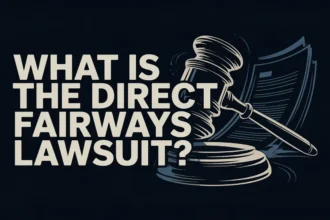Introduction to Kennedy Funding Lawsuit
In the complex world of finance and real estate, legal battles often emerge, drawing attention from investors and industry insiders alike. One such case making headlines is the Kennedy Funding lawsuit. As it unfolds, many are eager to understand its origins, key players, and potential ramifications for the future of funding practices.
This high-stakes legal drama has captivated audiences with its intricate web of accusations and defenses. With significant financial implications at stake, both sides are digging in their heels. What does this mean for those involved? And what can we learn from this unfolding scenario?
Join us as we delve into the details surrounding the Kennedy Funding lawsuit—unpacking its background, examining player dynamics, exploring arguments put forth by each side, and discussing how it might reshape the landscape going forward.
The Lawsuit: Background and Overview
The Kennedy Funding lawsuit centers around a financial dispute involving prominent real estate investments. It emerged in response to allegations of mismanagement and breach of contract related to funding agreements.
The case has garnered significant attention, primarily due to the scale of the investments involved. Various stakeholders are keenly observing how these proceedings will unfold.
At its core, the litigation raises important questions about fiduciary duties and accountability within investment practices. The intricacies surrounding the financial transactions add layers of complexity that make this case particularly noteworthy.
Both sides present compelling arguments rooted in legal precedents and contractual obligations. As details continue to emerge, many industry experts speculate on potential ramifications for similar financial arrangements moving forward.
Key Players Involved in the Lawsuit
The Kennedy Funding lawsuit features several influential players, each with a distinct role. At the center is kennedy funding lawsuit, a prominent real estate finance company known for providing loans to developers. Their financial practices have attracted scrutiny.
On the opposing side are various plaintiffs, including investors and stakeholders who claim mismanagement and breach of contract. They argue that their investments were mishandled, leading to significant losses.
Legal representatives on both sides play crucial roles in shaping the narrative of this case. Attorneys for the plaintiffs seek accountability while defending Kennedy’s legal team aims to protect its reputation and financial standing.
Additional parties involved include industry experts who may provide testimony regarding standard practices in commercial financing. Their insights could sway public opinion and impact court decisions significantly. Each participant adds layers of complexity to an already intricate situation.
Main Arguments from Both Sides
The Kennedy Funding lawsuit has sparked heated debates. On one side, plaintiffs argue that the funding practices were predatory. They contend that excessive fees and hidden terms led to significant financial strain on borrowers.
In contrast, the defense maintains that all agreements were transparent. They assert that borrowers willingly signed contracts after thorough explanations of terms. According to them, these deals provide essential capital for projects often overlooked by traditional lenders.
Additionally, plaintiffs highlight cases where clients faced unforeseen consequences due to lack of clarity in communication. The defense counters this narrative by emphasizing borrower responsibility in understanding their agreements fully.
Each argument reveals a complex interplay between lending practices and borrower awareness. This case showcases broader issues within financial systems affecting numerous stakeholders across various sectors.
Implications of the Outcome
The outcome of the Kennedy Funding lawsuit has far-reaching implications for investors and financial institutions alike. A ruling in favor of one party could set a precedent affecting future funding agreements.
If the plaintiffs win, it may encourage more aggressive litigation against funding firms. This could lead to increased scrutiny over contractual obligations and transparency. Investors might demand stricter terms to protect their interests.
Conversely, a victory for kennedy funding lawsuit could bolster investor confidence in alternative financing options. It would signal that such arrangements are legally sound and enforceable, potentially attracting new clients seeking capital.
The case also highlights the need for clarity in communication between parties involved in complex financial deals. As market dynamics evolve, understanding these legal nuances becomes essential for all stakeholders engaged with funding entities.
Lessons Learned and Future Considerations
The Kennedy Funding lawsuit highlights the complexities of financial agreements. Stakeholders must pay close attention to contract details. Misunderstandings can lead to costly legal battles.
Moreover, transparency is crucial in funding arrangements. Open communication fosters trust among parties involved. This approach can prevent disputes from escalating into litigation.
Future investors should conduct thorough due diligence. Understanding the full scope of potential risks will benefit all parties long-term. Legal counsel should be consulted to navigate intricate financing laws effectively.
The case serves as a reminder that adaptability is key in an ever-evolving financial landscape. Embracing changes and staying informed about regulations can help mitigate future issues related to funding disputes.
Conclusion
The Kennedy Funding lawsuit has captured significant attention in the financial and legal sectors. Its complexities highlight crucial aspects of funding practices, investor relationships, and regulatory frameworks.
As the case unfolds, it serves as a reminder of the importance of transparency in business dealings. Stakeholders must remain vigilant about their rights and responsibilities.
Moreover, this litigation may inspire changes within industry standards. Companies will likely reassess their policies to avoid similar disputes in the future.
For investors, understanding these developments is vital. As precedents are set or challenged, they could influence investment strategies moving forward.
Keeping an eye on this lawsuit will be important for anyone involved in real estate financing or related fields. The implications stretch far beyond just one company or individual; they resonate throughout the entire financial landscape.
FAQs
Understanding the Kennedy Funding Lawsuit: Key Insights and Implications
The Kennedy Funding lawsuit has stirred considerable interest in legal and financial circles. This case showcases the complexities of funding disputes, raising questions about contractual obligations and business ethics.
This blog aims to delve into those intricacies, exploring the background of the lawsuit, key players involved, main arguments from both sides, implications of potential outcomes, as well as lessons learned for future considerations.
The Lawsuit: Background and Overview
At its core, the Kennedy Funding lawsuit revolves around allegations made against a prominent real estate financing firm. The suit claims that financial misrepresentation occurred during a series of investment dealings. Industry insiders suggest that this case highlights broader issues within private equity firms’ operational practices.
Kennedy Funding has been known for facilitating large-scale real estate projects through various funding methods. However, when disagreements arose with certain investors over their returns and contract terms, it led to escalating tensions resulting in this high-stakes legal battle.
Key Players Involved in the Lawsuit
Several noteworthy figures are central to this case. On one side is Kennedy Funding’s management team—individuals with substantial experience in finance and real estate investment. They uphold their position by asserting that all agreements were honored according to industry standards.
On the other hand are several disgruntled investors who feel cheated out of promised returns. Their accounts paint a picture where transparency was lacking throughout negotiations—a narrative that raises red flags regarding fiduciary responsibility.
Main Arguments from Both Sides
Each side presents compelling arguments rooted deeply in their respective experiences within financing structures. Proponents for Kennedy Funding argue that investor expectations were not aligned with market realities at times; they claim risks associated with investments were clearly communicated upfront.
Conversely, plaintiffs emphasize what they believe is inadequate representation on behalf of investors’ interests—they assert crucial information was withheld or misrepresented during contract discussions leading them to invest unwisely based on false assumptions about risk levels involved.
Implications of the Outcome
The outcome could set significant precedents affecting

















